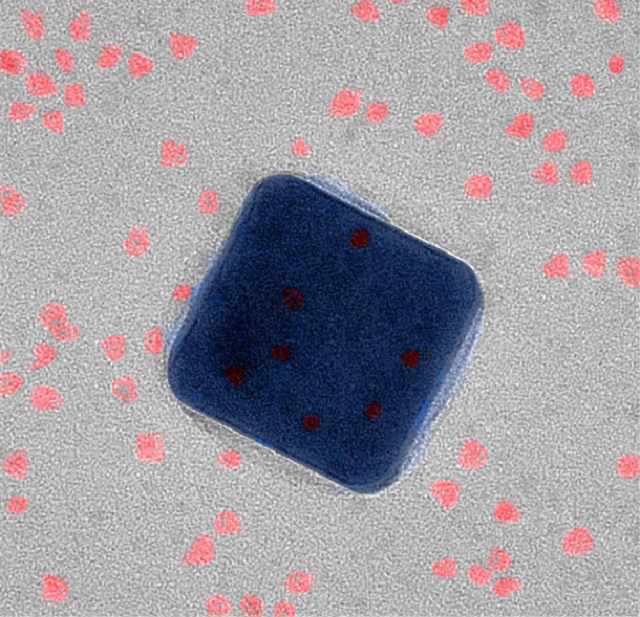 A nanoscale view of the new superfast fluorescent system using a transmission electron microscope. The silver cube is just 75-nanometers wide. The quantum dots (red) are sandwiched between the silver cube and a thin gold foil.
A nanoscale view of the new superfast fluorescent system using a transmission electron microscope. The silver cube is just 75-nanometers wide. The quantum dots (red) are sandwiched between the silver cube and a thin gold foil.
A team of researchers at Duke University have developed an ultrafast plasmonic device, which can turn on and off 90 billion times per second.
This light-emitting device could pave the way for optical communication between conventional electronic microchips or in optical computing chips. The study has been published in Nature Communications.
The smart phone’s battery, at its most fundamental level, powers countless of transistors by making electrons turn on and off many times per second. However, instead of using electrons, if microchips utilize photons to process and relay information, PCs could work at a relatively faster rate. To achieve this, engineers must first develop a light source, which can be flipped on and off instantly. Although lasers can be used for this purpose, they consume large amounts of energy, thus making them unsuitable for use in computer chips.
In the latest study, the researchers from the Pratt School of Engineering at Duke University are now closer to developing this so-called light source by pushing semiconductor quantum dots to produce light at over 90GHz. This plasmonic device could form the foundation of optical computing.
This is something that the scientific community has wanted to do for a long time. We can now start to think about making fast-switching devicesbased on this research, so there’s a lot of excitement about this demonstration.
Maiken Mikkelsen, an assistant professor of electrical and computer engineering and physics at Duke University
Plasmonics was used to achieve this new speed record. When the silver cube surface measuring just 75nm wide is illuminated with a laser, the free electrons on the cube’s surface begin to oscillate together in a wave. These oscillations produce their own light, which again reacts with the free electrons. The energy that gets trapped on the nanocube’s surface in this manner is referred to as a plasmon.
The plasmon produces a strong electromagnetic field between a thin gold foil and the silver nanocube located just 20 atoms away. This electromagnetic field interacts with quantum dots, which are packed between the gold foil and the nanocube. Quantum dots are spheres of semiconducting material measuring just 6nm wide. They create a directional and efficient emission of photons, which can be rapidly flipped on and off at over 90GHz.
“There is great interest in replacing lasers with LEDs for short-distance optical communication, but these ideas have always been limited by the slow emission rate of fluorescent materials, lack of efficiency and inability to direct the photons,” said Gleb Akselrod, a postdoctoral researcher in Mikkelsen’s laboratory. “Now we have made an important step towards solving these problems.”
“The eventual goal is to integrate our technology into a device that can be excited either optically or electrically,” said Thang Hoang, also a postdoctoral researcher in Mikkelsen’s laboratory. “That’s something that I think everyone, including funding agencies, is pushing pretty hard for.”
The researchers are now using the plasmonic structure to produce a photon source by packing a quantum dot in the space between the gold foil and the silver nanocube. Photon sources are required to facilitate secure quantum communications. The team is also attempting to place and direct the quantum dots to produce the fastest rates of fluorescence possible. In addition to its possible technological impacts, the study shows that popular materials need not be necessarily restricted by their inherent properties.
By tailoring the environment around a material, like we’ve done here with semiconductors, we can create new designer materials with almost any optical properties we desire. And that’s an emerging area that’s fascinating to think about.
Mikkelsen
The study was funded by the Air Force Office of Scientific Research (AFOSR, Grant No. FA9550-12-1-0491), the Air Force Office of Scientific Research Young Investigator Program (AFOSR, Grant. No. FA9550-15-1-0301), the Intelligence Community Postdoctoral Research Fellowship Program, the Lord Foundation of North Carolina, and the Ralph E. Powe Junior Faculty Enhancement Award of the Oak Ridge Associated University.
References